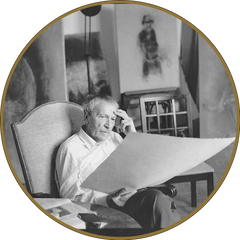Zoran Music biography

Zoran Music, Slovenian painter and engraver, is one of the most famous and admired artists of the 20th century. Born in 1909 in Boccavizza, a small village near Gorizia, in a Slovenian-speaking family, he left an indelible mark on the world of art. His life and artwork were marked by extraordinary and dramatic experiences that deeply influenced his artistic style. After completing his studies at the Academy of Art in Zagreb in 1934, Zoran Mušič embarked on a series of long journeys across Europe. During this period, he spent time in Madrid, where he was inspired by Spanish painting and visited great museums such as the Prado and the Escorial. This journey marked the beginning of a new phase in his painting, with the landscape of old Castile awakening in him the memory of his Dalmatian homeland.
However, the life of Zoran Mušič takes a dramatic turn during World War II. In November 1944, he was arrested by the Gestapo in Trieste on charges of collaboration and deported to the Dachau concentration camp. Despite the extremely difficult and dangerous circumstances, Zoran Mušič managed to secretly draw life in the camp. Twenty-four of his drawings, dated and signed Dachau 1945, were recently discovered and represent a touching document of the tragedy experienced during imprisonment. These drawings are now kept in the Museo Revoltella in Trieste and testify to the artist's ability to transform horror into artwork.
After his liberation in 1945, he returned to Italy and settled in Venice, where he married Ida Barbarigo Cadorin, who became his lifelong muse. Venice and the surrounding landscapes became a source of inspiration for his subsequent artworks. In 1950, he won the Gualino Prize at the Venice Biennale and subsequently the Paris Prize in 1951, confirming his talent and international recognition.
Zoran Mušič's painting undergoes continuous evolution over the years. From the depiction of Dalmatian landscapes in his youth, he increasingly focuses on the surrounding environment, abandoning the canons of three-dimensionality. He was influenced by elements of mosaics and Byzantine icons present in Venice and studied French lyrical abstraction during his stay in Paris in the '50s. One of Zoran Mušič's most acclaimed series, titled We are not the last (Nous ne sommes pas les derniers), dates between 1970 and 1976. This series represents the transformation of the horror and hell of imprisonment in the Dachau concentration camp into documents of a universal tragedy. These artworks were hugely successful and appreciated by critics.
The artworks of Zoran Mušič have been exhibited in numerous international exhibitions and are present in the most important museums in the world, including Italy, Slovenia, France, Spain, Germany, and the United States. His ability to capture the essence of tragedy and humanity in his paintings and drawings has made his artwork a powerful and moving testimony of the human condition. Zoran Mušič, also known as the painter of little horses for his recurring subject of horses, has left a lasting legacy in the global artistic landscape. His ability to transform horror into beauty and to grasp the essence of humanity in such a deep and touching way makes him a unique and unforgettable artist.
Zoran Mušič passed away on May 25, 2005, but his artwork continues to inspire and move those fortunate enough to discover his extraordinary artistic talent and his profound sensitivity towards humanity. His biography is a testament to the power of art in giving voice to those who have been oppressed and in revealing beauty even in the darkest circumstances.



